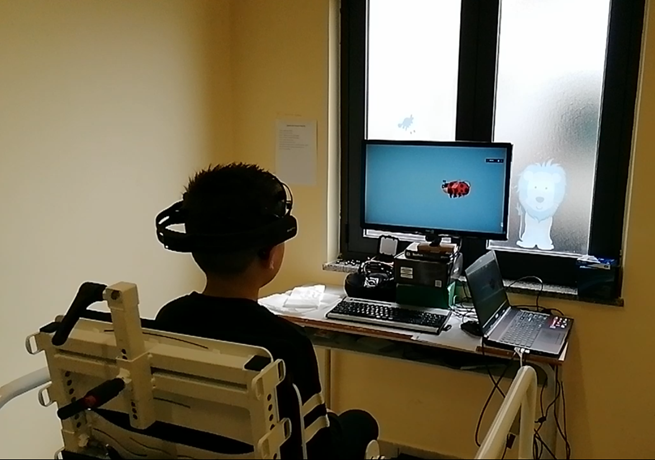
Application field
Affective computing, psychology, rehabilitation, education, learning
Technology
Electroencephalography, artificial intelligence, extended reality, statistics
Goals
Development of adaptive systems capable to recognize and adjust to the current emotional or cognitive state of the user. Therefore, specific neural patterns for a determined phenomenon must be identified in order to maximize the recognition performances and the cross-subject generalizability of the results.
In the emotional state detection, the aims are the EEG-based assessment of valence and arousal states using as reference theory the Circumplex Model of Affect and the assessment of different levels of fear of fear of height. In the engagement detection, the aim is to assess both the cognitive and the emotional engagement.
In cognitive mental state detection, the main focus concerns the real-time EEG-based detection of executive functions (working memory, inhibition, flexibility) fatigue for fall prediction and targeted rehabilitation intervention in cases of neurodegenerative disorders or ageing.
Activities
- Literature search and design of the experimental protocol.
- Initial screening of the sample and experimental campaign for the EEG signal acquisitions.
- Pre-processing of the EEG signal.
- Feature extraction and selection.
- Prototyping of the adaptive system able to detect and adjust to the current state of the user and experimental validation.
Challenges
- Improving the recognition performances and the cross-subject generalizability
- Management of the uncertainty: for the emotion recognition, the uncertainty is related to the reference theory, the eliciting stimuli, and the subjective reaction of the subject; in case of executive function fatigue detection, the uncertainty is related to the actual assessment that the subject is in a fatigued condition.
- Minimizing the number of EEG channels.
Bibliography
- Apicella, A., Arpaia, P., Mastrati, G., & Moccaldi, N. (2021). EEG-based detection of emotional valence towards a reproducible measurement of emotions. Scientific Reports, 11(1), 1-16.
- Apicella, A., Arpaia, P., Isgrò, F., Mastrati, G., & Moccaldi, N. (2022). A Survey on EEG-Based Solutions for Emotion Recognition With a Low Number of Channels. IEEE Access, 10, 117411-117428.
- Apicella, A., Arpaia, P., Giugliano, S., Mastrati, G., & Moccaldi, N. (2021). High-wearable EEG-based transducer for engagement detection in pediatric rehabilitation. Brain-Computer Interfaces, 1-11.
- Apicella, A., Arpaia, P., Esposito, A., Mastrati, G., & Moccaldi, N. (2022, May). Metrological foundations of emotional valence measurement through an EEG-based system. In 2022 IEEE International Instrumentation and Measurement Technology Conference (I2MTC) (pp. 1-6). IEEE.
- Apicella, A., Arpaia, P., Mastrati, G., Moccaldi, N., & Prevete, R. (2020, June). Preliminary validation of a measurement system for emotion recognition. In 2020 IEEE International Symposium on Medical Measurements and Applications (MeMeA) (pp. 1-6). IEEE.
- Angrisani, L., Arpaia, P., Esposito, A., Gargiulo, L., Natalizio, A., Mastrati, G., ... & Parvis, M. (2021). Passive and active brain-computer interfaces for rehabilitation in health 4.0. Measurement: Sensors, 18, 100246.
- Arpaia, P., Coyle, D., D’Errico, G., De Benedetto, E., De Paolis, L. T., du Bois, N., ... & Vallefuoco, E. (2022). Virtual Reality Enhances EEG-Based Neurofeedback for Emotional Self-regulation. In International Conference on Extended Reality (pp. 420-431). Springer, Cham.
- Apicella, A., Arpaia, P., Cataldo, A., D’Errico, G., Marocco, D., Mastrati, G., ... & Vallefuoco, E. (2022, October). Reproducible Assessment of Valence and Arousal Based on an EEG Wearable Device. In 2022 IEEE International Conference on Metrology for Extended Reality, Artificial Intelligence and Neural Engineering (MetroXRAINE) (pp. 661-666). IEEE.
- Arpaia, P., Calabrese, L., Chiarella, S. G., D’Errico, G., De Paolis, L. T., Grassini, S., ... & Vallefuoco, E. (2022, October). Mindfulness-based Emotional Acceptance in Combination with Neurofeedback for Improving Emotion Self-Regulation: a Pilot Study. In 2022 IEEE International Conference on Metrology for Extended Reality, Artificial Intelligence and Neural Engineering (MetroXRAINE) (pp. 465-470). IEEE.
- Arpaia, P., Mastrati, G., & Moccaldi, N. MetroXRaine competition-Emotion dataset.
- Arpaia, P., Covino, A., Cristaldi, L., Frosolone, M., Gargiulo, L., Mancino, F., ... & Moccaldi, N. (2022). A Systematic Review on Feature Extraction in Electroencephalography-Based Diagnostics and Therapy in Attention Deficit Hyperactivity Disorder. Sensors, 22(13), 4934.
- Angrisani, Leopoldo, et al. "Passive and active brain-computer interfaces for rehabilitation in health 4.0." Measurement: Sensors 18 (2021): 100246.
- Apicella, Andrea, et al. "EEG-based system for Executive Function fatigue detection." 2022 IEEE International Conference on Metrology for Extended Reality, Artificial Intelligence and Neural Engineering (MetroXRAINE). IEEE, 2022.
- Leopoldo Angrisani, Andrea Apicella, Pasquale Arpaia, Andrea Cataldo, Anna Della Calce, Allegra Fullin, Ludovica Gargiulo, Luigi Maffei, Nicola Moccaldi, Andrea Pollastro. Instrumentation for EEG-based monitoring of the executive functions in a dual-task framework (MEMEA 2022)





